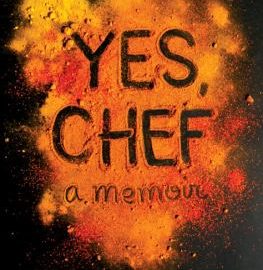
Bibliobites in November/December: Chasing Flavors
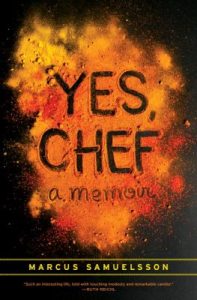 Unrelenting drive. Fierce determination. Boundless energy and ambition. Obsessive single-mindedness. Plus a dollop of anxiety. Put all these traits together and you have a recipe for what it takes to become a successful chef in the hyper-competitive world of fine dining. In addition to the above qualities, many of today’s cooking stars have unusual backgrounds and compelling life stories, none more so than Marcus Samuelsson, author of this month’s title, the classic memoir Yes, Chef. An Ethiopian by birth, he was adopted by a Swedish family at the age of three, trained in restaurants all over Europe as a teenager, and ultimately settled in New York City, where he owns multiple restaurants. He’s a James Beard award winner and is also a fixture on TV, having appeared on (and won) Top Chef Masters, and is currently the host of PBS’ No Passport Required. As is always the case with a memoir, the reader wants to know why and how someone arrived at where they are today. The steps may be convoluted, but often the goal is straightforward, and in this Samuelsson is no exception.
Unrelenting drive. Fierce determination. Boundless energy and ambition. Obsessive single-mindedness. Plus a dollop of anxiety. Put all these traits together and you have a recipe for what it takes to become a successful chef in the hyper-competitive world of fine dining. In addition to the above qualities, many of today’s cooking stars have unusual backgrounds and compelling life stories, none more so than Marcus Samuelsson, author of this month’s title, the classic memoir Yes, Chef. An Ethiopian by birth, he was adopted by a Swedish family at the age of three, trained in restaurants all over Europe as a teenager, and ultimately settled in New York City, where he owns multiple restaurants. He’s a James Beard award winner and is also a fixture on TV, having appeared on (and won) Top Chef Masters, and is currently the host of PBS’ No Passport Required. As is always the case with a memoir, the reader wants to know why and how someone arrived at where they are today. The steps may be convoluted, but often the goal is straightforward, and in this Samuelsson is no exception.
Samuelsson’s journey could be described with so many superlative adjectives that it’s hard to know where to start. Born during a severe famine in Ethiopia, it’s astonishing that he survived at all. Culturally, he grew up Swedish in his adoptive family, and fell in love with cooking during the innumerable Sunday afternoons he spent helping his grandmother prepare family dinner. Though he enjoyed being in the kitchen, his first love was soccer, and he devoted endless hours to perfecting his game, with the goal of playing on a professional level. When that door closed, he turned his considerable work ethic towards cooking. Once again, we read about the exhaustion and exhilaration of kitchen life: the drudgery of starting at the bottom (spending hours cleaning a walk-in refrigerator); the fear of making a career-ending mistake; the thrill of being on the line and creating original dishes. We wondered, as we have before, why kitchen culture is so intense and unforgiving. It’s anxiety-inducing to read about, let alone live through. Several opinions came to mind, among them the theory of a self-selecting population: the field often seems to attract adrenaline junkies and risk-takers. Sometimes a class system is at play, too; many enter the field at the bottom, as dishwashers or low-level prep workers, and claw their way through a Darwinian system without benefit of unattainable, expensive culinary training.
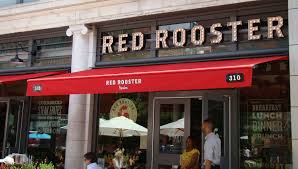 Though Samuelsson trained in multiple European countries, he had ambitions beyond traditional fine-dining restaurants. His culinary quest, as he repeatedly says, is about “chasing flavors,” and his desire to meld the many culinary influences in his life: African, Swedish, and ultimately, that of the Black community in the US. Samuelsson moved to New York City as a young man and immediately embraced the city’s diversity, and his quest for flavors expanded beyond anything he had once envisioned. Ultimately he opened the Red Rooster restaurant in Harlem, in which he’s been able to express all the aspects of his life and training through unique, and yet familiar, food.
Though Samuelsson trained in multiple European countries, he had ambitions beyond traditional fine-dining restaurants. His culinary quest, as he repeatedly says, is about “chasing flavors,” and his desire to meld the many culinary influences in his life: African, Swedish, and ultimately, that of the Black community in the US. Samuelsson moved to New York City as a young man and immediately embraced the city’s diversity, and his quest for flavors expanded beyond anything he had once envisioned. Ultimately he opened the Red Rooster restaurant in Harlem, in which he’s been able to express all the aspects of his life and training through unique, and yet familiar, food.
There actually weren’t an overwhelming number of comments about this title. Many of us already knew his story, but it’s likely that we were all simply stunned into silence by his incredible persistence and ultimate success. As one person put it, “what a remarkable life!” Though it’s obvious from the memoir that Samuelsson isn’t a perfect human being, you can’t help but cheer his achievements and applaud his triumphs. Our feelings were reflected in our rating: a stellar 4.25 out of a possible 5.
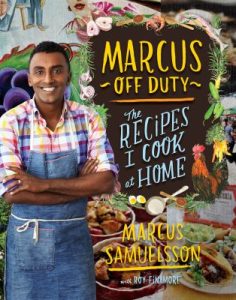 In addition to the memoir, we perused one of Samuelsson’s cookbooks, 2014’s Marcus Off Duty: The Recipes I Cook at Home. Even if you didn’t cook from this book, it’s a fun read. There are colorful and inviting photos of almost every recipe, and of the author’s Harlem neighborhood. Chapter headings feature a playlist of songs for you to enjoy while in the kitchen, all penned in a charming, “handwritten” font. But, what did we make while humming along?? One thing we discovered pretty quickly: when Marcus cooks at home, he has a lot more ingredients at the ready than we do! And, unsurprisingly for a chef, he doesn’t mind a bit of prep. Unfortunately, one of the simpler recipes in the book, quinoa with broccoli, cauliflower, and toasted coconut didn’t quite make the grade. Three people tried this, and all used the word “bland” to describe it. And, also unfortunately in this case, it made quite a bit and we struggled to finish it off.
In addition to the memoir, we perused one of Samuelsson’s cookbooks, 2014’s Marcus Off Duty: The Recipes I Cook at Home. Even if you didn’t cook from this book, it’s a fun read. There are colorful and inviting photos of almost every recipe, and of the author’s Harlem neighborhood. Chapter headings feature a playlist of songs for you to enjoy while in the kitchen, all penned in a charming, “handwritten” font. But, what did we make while humming along?? One thing we discovered pretty quickly: when Marcus cooks at home, he has a lot more ingredients at the ready than we do! And, unsurprisingly for a chef, he doesn’t mind a bit of prep. Unfortunately, one of the simpler recipes in the book, quinoa with broccoli, cauliflower, and toasted coconut didn’t quite make the grade. Three people tried this, and all used the word “bland” to describe it. And, also unfortunately in this case, it made quite a bit and we struggled to finish it off. 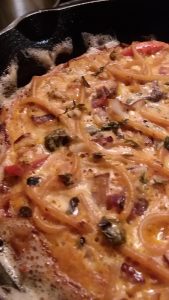 The-day-after pasta frittata fared somewhat better; two people made this. For one person it “wasn’t bad,” but for another this simple dish hit the spot. You did have to have already-cooked pasta with sauce on hand, which is great if you have that, and another step if you don’t. Still, it was a nice take on leftover pasta.
The-day-after pasta frittata fared somewhat better; two people made this. For one person it “wasn’t bad,” but for another this simple dish hit the spot. You did have to have already-cooked pasta with sauce on hand, which is great if you have that, and another step if you don’t. Still, it was a nice take on leftover pasta.
There were other main-dish hits as well: k-town noodles were “really good” with strong umami notes from kimchi, soy sauce, and sesame oil. 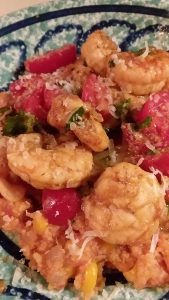 Red shrimp and spicy grits was a solid take on this classic (and popular) dish, though “I still wished the grits had cheese in them!” Orange-curry beef stir-fry with broccolini had “nice flavors” but was somewhat downgraded because it had “lots of ingredients [to prep].” Continuing with the Asian theme, peanut noodles with slaw were either “dry and gluey” or had “the best, most addictive peanut sauce I’ve made,” depending on who you talked to! A nod to Samuelsson’s Swedish upbringing, helga’s meatballs and gravy with carrot-apple mashed potatoes showed that grandmother really may know best; the meatballs were “great– moist and tender,” though the traditional cream gravy was a bit bland. The recipe’s headnote tells us that the author added carrot and apple to the mashed potatoes, but the result was “not worth the effort.” And firehouse stovetop clambake was a twist on a very traditional American dish; this was “really good” with the typical ingredients of shellfish, potatoes, and onions. Making it on the stove turned it into a nice wintertime treat.
Red shrimp and spicy grits was a solid take on this classic (and popular) dish, though “I still wished the grits had cheese in them!” Orange-curry beef stir-fry with broccolini had “nice flavors” but was somewhat downgraded because it had “lots of ingredients [to prep].” Continuing with the Asian theme, peanut noodles with slaw were either “dry and gluey” or had “the best, most addictive peanut sauce I’ve made,” depending on who you talked to! A nod to Samuelsson’s Swedish upbringing, helga’s meatballs and gravy with carrot-apple mashed potatoes showed that grandmother really may know best; the meatballs were “great– moist and tender,” though the traditional cream gravy was a bit bland. The recipe’s headnote tells us that the author added carrot and apple to the mashed potatoes, but the result was “not worth the effort.” And firehouse stovetop clambake was a twist on a very traditional American dish; this was “really good” with the typical ingredients of shellfish, potatoes, and onions. Making it on the stove turned it into a nice wintertime treat.
We tried some sides and snacks, too. Pickled tomato soup with corn bread croutons was “terrible– the vinegar overpowered everything.” That would be the half cup of cider vinegar in a smallish batch of soup. However, the market-fresh corn bread was a hit for both people who made it; buttermilk, cheddar cheese, scallions, and spices made for an extremely flavorful loaf. It kept well, too. 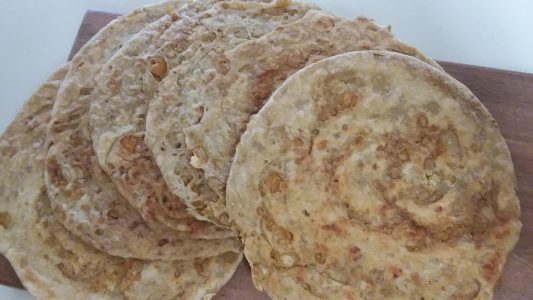 Aunt josulyn’s roti was a chickpea-stuffed flatbread that made a great snack or side for soup. These were a bit of a project, but the resulting flaky pastry and spiced filling were worth the effort. The recipe made 8 flatbreads, and leftovers reheated well. One person made coconut peanut butter, a component of sticky bacon sandwiches. We sampled this at our meeting, and all agreed that the spicing was unappealing. Cloves and nutmeg were overly dominant and produced an odd, almost medicinal effect. Not a keeper! Spiced nuts were much more successful flavor-wise, featuring the addictive sweet/salty combo. However, the spices and sugar “didn’t really coat the nuts,” which was a bit disappointing. But worth trying again.
Aunt josulyn’s roti was a chickpea-stuffed flatbread that made a great snack or side for soup. These were a bit of a project, but the resulting flaky pastry and spiced filling were worth the effort. The recipe made 8 flatbreads, and leftovers reheated well. One person made coconut peanut butter, a component of sticky bacon sandwiches. We sampled this at our meeting, and all agreed that the spicing was unappealing. Cloves and nutmeg were overly dominant and produced an odd, almost medicinal effect. Not a keeper! Spiced nuts were much more successful flavor-wise, featuring the addictive sweet/salty combo. However, the spices and sugar “didn’t really coat the nuts,” which was a bit disappointing. But worth trying again.
This title is one that, at first blush, seemed approachable and fun. However, Samuelsson’s flavors and spicing are often quite different than what we’re accustomed to, and sometimes we thought it worked incredibly well, but sometimes it didn’t. This title clearly reflects that Samuelsson has chased flavors from all over the world. Some combinations we didn’t care for might become favorites given enough exposure! Another flaw for us was the extensive ingredient lists found in many of the recipes. Especially in December, most of us are looking for uncomplicated dishes. So the fault may be in the timing of this title rather than the book itself. Whatever the reason, when it came to a vote, we averaged out to a 1.825 out of a possible 5. Ouch! Sorry Marcus! We think you’re amazing, but perhaps we’ll just hope to visit one of your restaurants someday, rather than cooking from your books at home.
Our first meeting of 2024 is coming up soon. Please join us on Friday, January 26 at 11 AM in the Fireplace Room. We’ll be discussing blogger Kathryne Taylor’s Love Real Food. Copies are still available at the main circulation desk or via curbside pickup. Give it a glance, and see you on the 26th.






